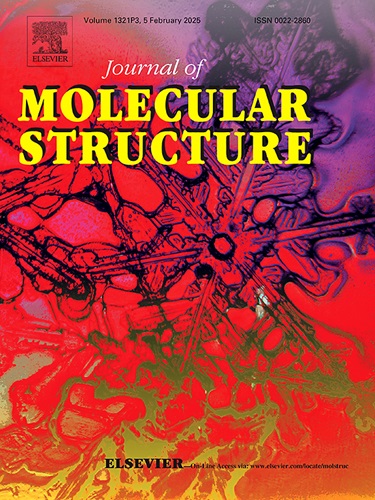新型n4 -取代和c2 -二取代1,4-苯并噻嗪-1,1-二氧化衍生物的合成:乳腺癌治疗的综合计算策略
IF 4
2区 化学
Q2 CHEMISTRY, PHYSICAL
引用次数: 0
摘要
本研究介绍了一种直接高效的合成方法,用于制备 1,4-苯并噻嗪-3-酮-1,1-二氧化物衍生物,特别是 N4 取代的化合物 3a-c 和 C2 取代的化合物 4-12,这些化合物是通过与单溴化剂进行烷基化反应,将 C2 位的甲氨基质子活化后,通过将硫转化为砜基团而得到的。所有合成化合物都通过 1H 和 13C-NMR 光谱数据以及 HRMS 分析进行了表征。此外,化合物 3c、4、5、9 和 11 还通过单晶 X 射线衍射分析得到了证实。合成的化合物通过了硅学研究评估,包括生物活性网络药理学、毒性预测、理化性质、分子对接和分子动力学模拟。所有设计的化合物(3c、4-12)都表现出良好的理化性质。分子对接研究显示,化合物 7 和 10 与靶蛋白 AKT1 之间存在良好的相互作用。与标准药物 Capivasertib(-8.40 kcal/mol)相比,化合物 7 和 10 的低能构象(分别为 -8.02 kcal/mol 和 -8.29 kcal/mol)显示出最有利的对接得分。分子动力学分析表明,化合物 7 显示出最稳定的配体 RMSD 和紧凑的分子构象,突出了其作为靶向 AKT1 的先导候选化合物的潜力。本文章由计算机程序翻译,如有差异,请以英文原文为准。

Synthesis of novel N4-substituted and C2-disubstituted 1,4-benzothiazine-1,1-dioxide derivatives: Integrative computational strategies for breast cancer therapy
This study presents a straightforward and efficient synthetic method for the preparation of 1,4-benzothiazine-3-one-1,1-dioxide derivatives, specifically N4-substituted compounds 3a-c and C2-disubstituted compounds 4–12, which were obtained via alkylation reactions with monobrominated agents following activation of the methylinic protons at the C2 position through the transformation of sulfur into a sulfone group. All synthesized compounds were characterized by their 1H- and 13C-NMR spectral data and HRMS analysis. Furthermore, compounds 3c, 4, 5, 9, and 11 additionally confirmed by single-crystal X-ray diffraction analysis. The synthesized compounds were evaluated through in silico studies, including network pharmacology for bioactivity, toxicity prediction, physicochemical properties, molecular docking, and molecular dynamics simulations. All designed compounds (3c, 4–12) exhibited favorable physicochemical properties. Molecular docking studies revealed favorable interactions between compounds 7 and 10 with the target protein AKT1. Compounds 7 and 10 showed the most favorable docking scores with low-energy conformations (-8.02 kcal/mol and -8.29 kcal/mol, respectively), compared to the standard drug Capivasertib (-8.40 kcal/mol). Molecular dynamics analysis showed that compound 7 demonstrated the most stable ligand RMSD and a compact molecular conformation, highlighting its potential as a lead candidate for targeting AKT1.
求助全文
通过发布文献求助,成功后即可免费获取论文全文。
去求助
来源期刊

Journal of Molecular Structure
化学-物理化学
CiteScore
7.10
自引率
15.80%
发文量
2384
审稿时长
45 days
期刊介绍:
The Journal of Molecular Structure is dedicated to the publication of full-length articles and review papers, providing important new structural information on all types of chemical species including:
• Stable and unstable molecules in all types of environments (vapour, molecular beam, liquid, solution, liquid crystal, solid state, matrix-isolated, surface-absorbed etc.)
• Chemical intermediates
• Molecules in excited states
• Biological molecules
• Polymers.
The methods used may include any combination of spectroscopic and non-spectroscopic techniques, for example:
• Infrared spectroscopy (mid, far, near)
• Raman spectroscopy and non-linear Raman methods (CARS, etc.)
• Electronic absorption spectroscopy
• Optical rotatory dispersion and circular dichroism
• Fluorescence and phosphorescence techniques
• Electron spectroscopies (PES, XPS), EXAFS, etc.
• Microwave spectroscopy
• Electron diffraction
• NMR and ESR spectroscopies
• Mössbauer spectroscopy
• X-ray crystallography
• Charge Density Analyses
• Computational Studies (supplementing experimental methods)
We encourage publications combining theoretical and experimental approaches. The structural insights gained by the studies should be correlated with the properties, activity and/ or reactivity of the molecule under investigation and the relevance of this molecule and its implications should be discussed.
 求助内容:
求助内容: 应助结果提醒方式:
应助结果提醒方式:


